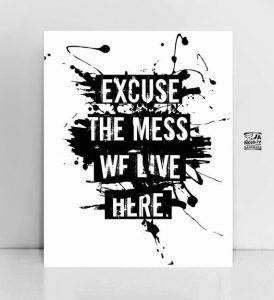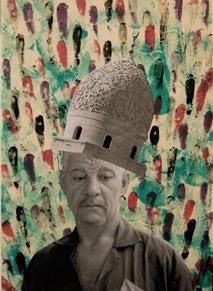Author Archives: Idil Sevin Cimen
Publish or Perish!
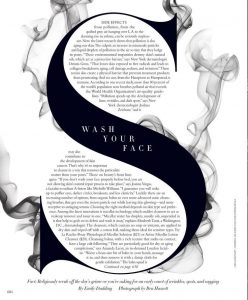 This is my first chosen image. I was drawn to this as soon as I saw it. The hierarchy is amazing. They exaggeration of the S really attracts peoples attention, and you will definitely not miss it. So thats the first positive of this layout, the fact that it draws the audience in at first glance. They have highlighted the S for the “side effects” which is what people would want the most information on. In the centre they have placed the title “wash your face.” The type that they have used it quite bold and the whole imagine looks powerful altogether. The contrast between the black and white has also given this article a less is more vibe. They have no overloaded with colours, this is probably because the article is not such a positive or cheery topic. The black and white colours highlight the seriousness they are trying to put across. The smoke appearing to come from the S also shows something of a toxic nature, something that is causing problems for the S. Again this is to highlight the side effects, the toxic and negative side effects.
This is my first chosen image. I was drawn to this as soon as I saw it. The hierarchy is amazing. They exaggeration of the S really attracts peoples attention, and you will definitely not miss it. So thats the first positive of this layout, the fact that it draws the audience in at first glance. They have highlighted the S for the “side effects” which is what people would want the most information on. In the centre they have placed the title “wash your face.” The type that they have used it quite bold and the whole imagine looks powerful altogether. The contrast between the black and white has also given this article a less is more vibe. They have no overloaded with colours, this is probably because the article is not such a positive or cheery topic. The black and white colours highlight the seriousness they are trying to put across. The smoke appearing to come from the S also shows something of a toxic nature, something that is causing problems for the S. Again this is to highlight the side effects, the toxic and negative side effects.
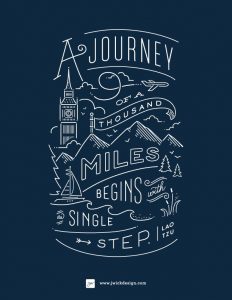 A very simple typography publication. Has a strong hand made feel to it, almost like a simple doodle. Very well put together, along with the white on dark blue. The colour scheme draws attention to the centre where the artist most likely wanted it to be. The illustrations gives off a happy and friendly vibe, which could be the reason some people become drawn towards it.
A very simple typography publication. Has a strong hand made feel to it, almost like a simple doodle. Very well put together, along with the white on dark blue. The colour scheme draws attention to the centre where the artist most likely wanted it to be. The illustrations gives off a happy and friendly vibe, which could be the reason some people become drawn towards it.
- Jennifer Wick Laos (n.d) Typographic Poster Available at: https://www.google.co.uk/amp/s/www.pinterest.com/amp/pin/510384570248084351/ (Accessed 28 November 2017)
- Ben Hassell (n.d) Harper’s Bazaar Available at: https://www.pinterest.co.uk/harpersbazaar/ (Accessed 28 November 2017)
- Anonymous (n.d) Scandinavian posters Available at: https://www.pinterest.co.uk/ManonGhiurco/scandinavian-posters/ (Accessed 28 November 2017)
Show, Reveal, Deconstruct (Postmodernism)
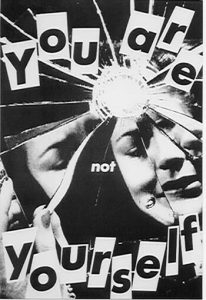 Again a very different design. The placement is not in perfect order, type is scattered around and there is again no use of colour. The design is very strong on its own, no colour was needed. The quote works well with the image used, pointing that the person in the cracked mirror is not themselves. I am interested in the cut out look of the typography, looks almost child like.
Again a very different design. The placement is not in perfect order, type is scattered around and there is again no use of colour. The design is very strong on its own, no colour was needed. The quote works well with the image used, pointing that the person in the cracked mirror is not themselves. I am interested in the cut out look of the typography, looks almost child like.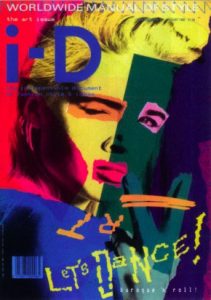 Because I gave two examples of postmodernism art without colour, I decided to choose one with colour for the final. This one is such an eye catching design, guaranteed to grab the audiences attention. This design definitely cannot be missed. This is the upside of postmodernism work, I think it grabs the attention of many people. Placements look great, the whole cut and paste look is adding more to the busy look of the page.
Because I gave two examples of postmodernism art without colour, I decided to choose one with colour for the final. This one is such an eye catching design, guaranteed to grab the audiences attention. This design definitely cannot be missed. This is the upside of postmodernism work, I think it grabs the attention of many people. Placements look great, the whole cut and paste look is adding more to the busy look of the page.
- Anonymous (n.d) posters. Available at https://www.pinterest.co.uk/pin/432345632962991346/ (Accessed 20 November 2017)
- Xinying (2011) ‘Postmodernism? What exactly does Postmodernism art look like?’ Post Modernism Graphic Styles 23 August Available at: http://postmodernismgraphicstyles.blogspot.co.uk/2011/08/post-modernism-visuals.html?m=1 (Accessed 20 November 2017)
- Xinying (2011) ‘Postmodernism? What exactly does Postmodernism art look like?’ Post Modernism Graphic Styles 23 August Available at: http://postmodernismgraphicstyles.blogspot.co.uk/2011/08/post-modernism-visuals.html?m=1 (Accessed 20 November 2017)
Sensibility, Spirit and Meaning (Counter Culture)
In this photograph, you can see the handmade typography on their poster. It looks like a psychedelic typeface which relates to the environmental organisation they created. Psychedelia reminds me of nature, natural, flowy and altogether a positive image. So, I think that by choosing to create their poster with this specific type really worked for them. It gives people a feel of their organisation. Typography is so powerful that people do receive vibes from certain types. Also, the small illustration makes the whole thing more playful.
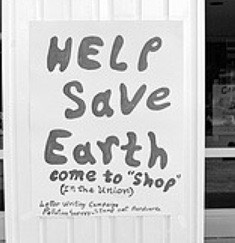 This second poster is again using psychedelic type. Although it is not as extreme as the first poster. It relates to the whole Earth theme once again, adding to the natural look. This one is not as neat and tidy, or as put in order. It appears to be more scattered. Although this could be to add more to the natural feel that the makers are going for. It also adds a more playful and fun feel to the posters proposal. It seems to be not a very serious poster, I am basing this just off of the type that was used. This shows again how powerful type can be.
This second poster is again using psychedelic type. Although it is not as extreme as the first poster. It relates to the whole Earth theme once again, adding to the natural look. This one is not as neat and tidy, or as put in order. It appears to be more scattered. Although this could be to add more to the natural feel that the makers are going for. It also adds a more playful and fun feel to the posters proposal. It seems to be not a very serious poster, I am basing this just off of the type that was used. This shows again how powerful type can be.
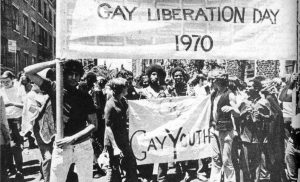 This is a gay youth march in the 1970’s. The typography used here is very simple, not much to it. Just a plain title, and year. Does not give a whole load of information but we all know what it is. Sometimes less is more, although not much is put onto this, it gives a big message. The type that is used, is quite bold and out there. It definitely attracts attention in my opinion. It’s so neat and a strong typeface, it is powerful in itself.
This is a gay youth march in the 1970’s. The typography used here is very simple, not much to it. Just a plain title, and year. Does not give a whole load of information but we all know what it is. Sometimes less is more, although not much is put onto this, it gives a big message. The type that is used, is quite bold and out there. It definitely attracts attention in my opinion. It’s so neat and a strong typeface, it is powerful in itself.- Anonymous (2009) The First Earth Day–Bell–Bottoms And Gas Masks Available at: https://news.nationalgeographic.com/news/2009/04/photogalleries/first-earth-day-1970-pictures/photo7.html (Accessed 28 November 2017)
- Anonymous (2009) The Specter of Environmentalism Available at: http://archive.oah.org/special-issues/teaching/2009_06/ex3.html (Accessed 28 November 2017)
- Anonymous (2012) 1ST ANNUAL GAY PRIDE MARCH, 1970 Available at: https://www.charentonmacerations.com/1st-annual-gay-pride-march-1970-2/ (Accessed 28 November 2017)
Technology is the mortal enemy of art
- Zaher, M. (n.d) The Impact Of Digital Technology On Art And Artists Available at: http://www.midanmasr.com/en/article.aspx?articleID=200#
- Aleksandr Rodchenko (n.d) Who We Are Available at: https://www.behance.net/gallery/12919695/Constructivism-Manifesto-Booklet (Accessed on 20 November 2017)
Is it possible to be truly authentic?
Is it possible to be truly authentic?
Compare and Contrast
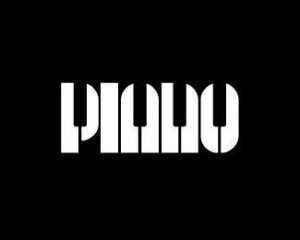 The first poster is a visual pun. It says “piano” but the typography appears to be piano keys. Which of course relates to the word itself. This is a smart visual pun, quite an obvious one. Not every visual pun is as clear as this, some are difficult to figure out or understand. The colours used are minimum, black and white. Simple, plain yet affective. The black is powerful, taking up almost the whole poster. But of course the keys are white, to point out the fact that they are meant to show off piano keys. If any other colour was used, for example pink, it wouldn’t fit the typical image of a piano.
The first poster is a visual pun. It says “piano” but the typography appears to be piano keys. Which of course relates to the word itself. This is a smart visual pun, quite an obvious one. Not every visual pun is as clear as this, some are difficult to figure out or understand. The colours used are minimum, black and white. Simple, plain yet affective. The black is powerful, taking up almost the whole poster. But of course the keys are white, to point out the fact that they are meant to show off piano keys. If any other colour was used, for example pink, it wouldn’t fit the typical image of a piano. 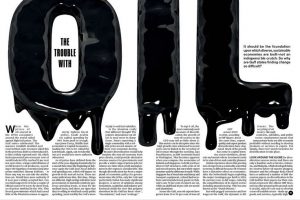 The second one is from a magazine. This is great hierarchy, with exaggerated “OIL” placed on the double spread. The “OIL” really catches the audiences eye, dragging them in. Also they have created this dripping effect, relating to the word oil. The first poster and this relates, as they are both classed as visual puns. It is a smart design, the paragraphs beneath are placed around the dripping of the oil, which makes it look unique and different. The article is all about the trouble with oil, so a very dark and unpleasing colour is used to portray the oil. Just like a very dark colour was used for the “PIANO” poster. Black is a colour that is very powerful. It is dark, gooey, sticky looking. An all round a negative image. This works with putting across their opinions on the troubles with oil.
The second one is from a magazine. This is great hierarchy, with exaggerated “OIL” placed on the double spread. The “OIL” really catches the audiences eye, dragging them in. Also they have created this dripping effect, relating to the word oil. The first poster and this relates, as they are both classed as visual puns. It is a smart design, the paragraphs beneath are placed around the dripping of the oil, which makes it look unique and different. The article is all about the trouble with oil, so a very dark and unpleasing colour is used to portray the oil. Just like a very dark colour was used for the “PIANO” poster. Black is a colour that is very powerful. It is dark, gooey, sticky looking. An all round a negative image. This works with putting across their opinions on the troubles with oil.- Anonymous (n.d) Amazing use of typography Available at: https://www.pinterest.co.uk/pin/493284965421569625/ (Accessed 20 November 2017)
- Anonymous (n.d) Piano Typography Available at: https://www.google.co.uk/amp/s/www.pinterest.com/amp/pin/366199013435871480/ (Accessed 20 November 2017)
TERMINAL BAR
Terminal Bar is an amazing short film, which perfectly draws in the audience immediately This short movie is a great example that certain tempo of imagery and music can keep people intrigued. This 22 minute film is directed by Stefan Nadelman, starring Sheldon Nadelman.
Shelden Nadelman shows the thousands of black and white photographs he took between 1972 to 1982 of his customers, while he was the bar tender at Terminal Bar. Along with his photographs there came great memories and stories, which he willingly shared. The sharing of the stories most definitely keeps the audience entertained, wanting to hear more. The whole film is driven by photographs, and up beat music.
Sheldon Nadelman has a very lively and bubbly way of telling his vivid memories from the Bar. From people sleeping on sidewalks, to eventually the bar turning into a gay bar. He tells the audience as much as he can remember and recall from his past.
As the movie is coming to an end, many portraits start to go by very quickly. As they become faster, the music becomes more upbeat, matching the pace of the photographs. There are portraits coming into frame left, right and centre with a rapid pace. This gives an almost hypnotising affect, which leads the audience giving the film full attention, to not miss a thing.
Maybe a calmer approach would have worked better. Slower, so the audience can fully examine, focus and study the portraits. Overall it is unique, Stefan Nadelman’s individual way worked.

